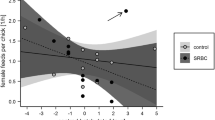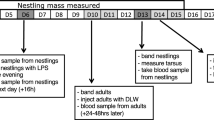Abstract
The maintenance of an effective immune system may entail physiological costs only affordable by individuals in good condition. Some species, like Black-legged Kittiwakes (Rissa tridactyla) in the high arctic, experience important physiological changes during breeding in order to fulfil their reproductive goals. We studied the effects of breeding effort on the cell-mediated immunity (CMI) of adult breeding Kittiwakes. Parent Kittiwakes showed a significant decrease in CMI from hatching to 15 days into the chick-rearing period, when both parents are known to experience a drastic increase in energy expenditure together with important physiological adjustments. Despite being a long-lived species with biparental care, parent Kittiwakes at the northern border of their breeding range, seem to experience important reproductive immunosupression, even during favourable breeding years.

Similar content being viewed by others
References
Alonso-Alvarez C, Tella JL (2001) Effects of experimental food restriction and body-mass changes on the avian T-cell-mediated immune response. Can J Zool 79:101–105
Ardia DR (2005) Individual quality mediates trade-offs between reproductive effort and immune function in tree swallows. J Anim Ecol 74:517–524
Barrett RT (1978) Adult body temperatures and the development of endothermy in the kittiwake (Rissa tridactyla). Astarte 11:113–116
Bech C, Langseth I, Moe B, Fyhn M, Gabrielsen GW (2002) The energy economy of the arctic-breeding kittiwake (Rissa tridactyla): a review. Comp Biochem Physiol A 133:765–770
Bonneaud C, Mazuc J, González G, Haussy C, Chastel O, Faivre B, Sorci G (2003) Assessing the cost of mounting an immune response. Am Nat 161:367–380
Bourgeon S, Criscuolo F, Le Maho Y, Raclot T (2006) Phytohemagglutinin response and immunoglobulin index decrease during incubation fasting in female common eiders. Physiol Biochem Zool 79:793–800
Cam E, Monnat JY, Hines JE (2003) Long-term fitness consequences of early conditions in the kittiwake. J Anim Ecol 72:411–424
Cichon M, Dubiec A, Chadzinska M (2001) The effect of elevated reproductive effort on humoral immune function in collared flycatcher females. Acta Oecologica 22:71–76
Clayton DH, Moore J (1997) Host-parasite evolution. General principles and avian models. Oxford University Press, Oxford
Fyhn M, Gabrielsen GW, Nordøy ES, Moe B, Lagnseth I, Bech C (2001) Individual variation in field metabolic rate of kittiwakes (Rissa tridactyla) during the chick-rearing period. Physiol Biochem Zool 74:343–355
Gasparini J, Roulin A, Gill VA, Hatch SA, Boulinier T (2006) In kittiwakes food availability partially explains the seasonal decline in humoral immunocompetence. Funct Ecol 20:457–463
Golet GH, Irons DB, Costa DP (2000) Energy costs of chick rearing in black-legged kittiwakes (Rissa tridactyla). Can J Zool 78:982–991
Hanssen SA, Hasselquist D, Folstad I, Erikstad KE (2004) Costs of immunity: immune responsiveness reduces survival in a vertebrate. Proc R Soc Lond B 271:925–930
Hanssen SA, Hasselquist D, Folstad I, Erikstad KE (2005) Cost of reproduction in a long-lived bird: incubation effort reduces immune function and future reproduction. Proc R Soc Lond B 272:1039–1046
Harshman LG, Zera AJ (2007) The cost of reproduction: the devil in the details. Trends Ecol Evol 22:80–86
Ilmonen P, Taarna T, Hasselquist D (2002) Are incubation costs in female pied flycatchers expressed in humoral immune responsiveness or breeding success? Oecologia 130:199–204
Kennedy MW, Nager RG (2006) The perils and prospects of using phytohaemagglutinin in evolutionary ecology. Trends Ecol Evol 21:653–655
Knowles SCL, Nakagawa S, Sheldon BC (2009) Elevated reproductive effort increases blood parasitemia and decreases immune function in birds: a meta-regression approach. Funct Ecol 23:405–415
Langseth I, Moe B, Bech C (2001) Reduction in body mass and basal metabolic rate in breeding female black-legged kittiwakes Rissa tridactyla: an adaptation to reduce maintenance costs. Atlantic Seabirds 3:165–178
Lessells CM, Boag PT (1987) Unrepeatable repeatabilities: a common mistake. Auk 104:116–121
Martin LB, Scheuerlein A, Wikelski M (2003) Immune activity elevates energy expenditure of house sparrows: a link between direct and indirect costs? Proc R Soc Lond B 270:153–158
Martin LB, Hasselquist D, Wikelski M (2006) Investment in immune defence is linked to pace of life in house sparrows. Oecologia 147:565–575
McCoy KD, Boulinier T, Tirard C (2005) Comparative host–parasite population structures: disentangling prospecting and dispersal in the black-legged kittiwake Rissa tridactyla. Mol Ecol 14:2825–2838
Merino S, Moreno J, Tomás G, Martínez J, Morales J, Martínez de la Puente J, Osorno JL (2006) Effects of parental effort on blood stress protein HSP60 and immunoglobulins in female blue tits: a brood size manipulation experiment. J Anim Ecol 75:1147–1153
Moe B, Langseth I, Fyhn M, Gabrielsen GW, Bech C (2002) Changes in body condition in breeding kittiwakes Rissa tridactyla. J Avian Biol 33:225–234
Moe B, Stempniewicz L, Jakubas D, Angelier F, Chastel O, Dinessen F, Gabrielsen GW, Hanssen F, Karnovsky NJ, Rønning B, Welcker J, Wojczulanis-Jakubas K, Bech C (2009) Climate change and phenological responses of two seabird species breeding in the high-arctic. Mar Ecol Prog Ser 393:235–246
Morales J, Moreno J, Merino S, Tomás G, Martínez J, Garamszegi LZ (2004) Associations between immune parameters, parasitism, and stress in breeding pied flycatcher (Ficedula hypoleuca) females. Can J Zool 82:1484–1492
Moreno J, Sanz JJ, Arriero E (1999) Reproductive effort and T-lymphocyte cell-mediated immunocompetence in female pied flycatchers Ficedula hypoleuca. Proc R Soc Lond B 266:1105–1109
Nilsson J-Å, Granbom M, Råberg L (2007) Does the strength of an immune response reflect its energetic cost? J Avian Biol 38:488–494
Nordling D, Andersson M, Zohari S, Gustafsson L (1998) Reproductive effort reduces specific immune response and parasite resistance. Proc R Soc Lond B 265:1291–1298
Norris K, Evans MR (2000) Ecological immunology: life history trade-offs and immune defence in birds. Behav Ecol 11:19–26
Ots I, Kerimov AB, Ivankina EV, Ilyina T, Horak P (2001) Immune challenge affects basal metabolic activity in wintering great tits. Proc R Soc Lond B 268:1175–1181
Piersma T (1997) Do global patterns of habitat use and migration strategies co-evolve with relative investments in immunocompetence due to spatial variation in parasite pressure? Oikos 80:623–631
Råberg L, Grahn M, Hasselquist D, Svensson E (1998) On the adaptive significance of stress-induced immunosuppression. Proc R Soc Lond B 265:1637–1641
Rønning B, Moe B, Chastel O, Broggi J, Langset M, Bech C (2008) Metabolic adjustments in breeding female kittiwakes (Rissa tridactyla) include changes in kidney metabolic intensity. J Comp Physiol B 178:779–784
Sheldon BC, Verhulst S (1996) Ecological immunology: costly parasite defences and trade-offs in evolutionary ecology. Trends Ecol Evol 11:317–321
Smits JE, Bortolotti GR, Tella JL (1999) Simplifying the phytohemagglutinin skin-testing technique in studies of avian immunocompetence. Funct Ecol 13:567–572
Soler JJ, Moreno J, Potti J (2003) Environmental, genetic and maternal components of immunocompetence of nestling pied flycatchers from a cross-fostering study. Evol Ecol Res 5:259–272
Speakman JR (2005) Body size, energy metabolism and lifespan. J Exp Biol 208:1717–1730
Staszewski V, McCoy KD, Tvera T, Boulinier T (2007) Interannual dynamics of antibody levels in naturally infected long-lived colonial birds. Ecology 88:3183–3191
Stearns SC (2000) Life history evolution: successes, limitations, and prospects. Naturwissenschaften 87:476–486
Tella JL, Lemus JA, Carrete M, Blanco G (2008) The PHA test reflects acquired t-cell mediated immunocompetence in birds. PLoS ONE 3(9):e3295
Acknowledgments
Permission to carry out the study in the Kittiwake colonies was provided by the Governor of Svalbard (Sysselmannen; ref. 2004/00884-4 a522-01), while permission to perform the PHA injections was given by the Norwegian National Animal Research Authority (Forsøksdyrutvalget; ref. 2005/20577). J.B. was funded by EC Marie Curie EVK1-CT-2002-57003 fellowship, while B.R., C.B. and M.L. were funded by Norwegian Polar Institute. Thanks are due to to the staff at Kings Bay and Norsk Polarinstitutt for logistic support. We also thank Geir Wing Gabrielsen and Olivier Chastel for help during the field season. We are indebted with Jordi Figuerola for his valuable comments on previous versions of the manuscript.
Author information
Authors and Affiliations
Corresponding author
Additional information
Communicated by P. H. Becker.
Rights and permissions
About this article
Cite this article
Broggi, J., Langset, M., Rønning, B. et al. Parent Kittiwakes experience a decrease in cell-mediated immunity as they breed. J Ornithol 151, 723–727 (2010). https://doi.org/10.1007/s10336-010-0510-3
Received:
Revised:
Accepted:
Published:
Issue Date:
DOI: https://doi.org/10.1007/s10336-010-0510-3




